Related Research Articles
A nuclear electric rocket is a type of spacecraft propulsion system where thermal energy from a nuclear reactor is converted to electrical energy, which is used to drive an ion thruster or other electrical spacecraft propulsion technology. The nuclear electric rocket terminology is slightly inconsistent, as technically the "rocket" part of the propulsion system is non-nuclear and could also be driven by solar panels. This is in contrast with a nuclear thermal rocket, which directly uses reactor heat to add energy to a working fluid, which is then expelled out of a rocket nozzle.
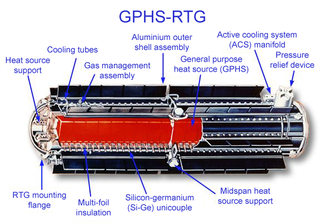
A radioisotope thermoelectric generator, sometimes referred to as a radioisotope power system (RPS), is a type of nuclear battery that uses an array of thermocouples to convert the heat released by the decay of a suitable radioactive material into electricity by the Seebeck effect. This type of generator has no moving parts and is ideal for deployment in remote and harsh environments for extended periods with no risk of parts wearing out or malfunctioning.

A power station, also referred to as a power plant and sometimes generating station or generating plant, is an industrial facility for the generation of electric power. Power stations are generally connected to an electrical grid.
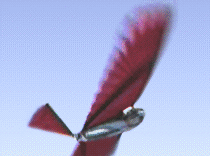
An ornithopter is an aircraft that flies by flapping its wings. Designers sought to imitate the flapping-wing flight of birds, bats, and insects. Though machines may differ in form, they are usually built on the same scale as flying animals. Larger, crewed ornithopters have also been built and some have been successful. Crewed ornithopters are generally either powered by engines or by the pilot.
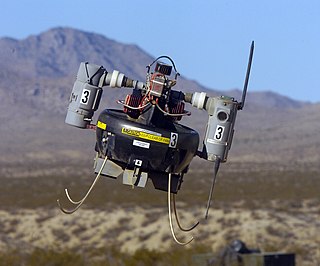
A micro air vehicle (MAV), or micro aerial vehicle, is a class of man-portable miniature UAVs whose size enables them to be used in low altitude, close-in support operations. Modern MAVs can be as small as 5 centimeters. Development is driven by commercial, research, government, and military purposes; with insect-sized aircraft reportedly expected in the future. The small craft allows remote observation of hazardous environments inaccessible to ground vehicles. MAVs have been built for hobby purposes such as aerial robotics contests and aerial photography.

Cogeneration or combined heat and power (CHP) is the use of a heat engine or power station to generate electricity and useful heat at the same time.
Robot locomotion is the collective name for the various methods that robots use to transport themselves from place to place.
Energy harvesting (EH) – also known as power harvesting,energy scavenging, or ambient power – is the process by which energy is derived from external sources, then stored for use by small, wireless autonomous devices, like those used in wearable electronics, condition monitoring, and wireless sensor networks.

A radio-controlled aircraft is a small flying machine that is radio controlled by an operator on the ground using a hand-held radio transmitter. The transmitter continuously communicates with a receiver within the craft that sends signals to servomechanisms (servos) which move the control surfaces based on the position of joysticks on the transmitter. The control surfaces, in turn, directly affect the orientation of the plane.

Water splitting is the chemical reaction in which water is broken down into oxygen and hydrogen:

Bird flight is the primary mode of locomotion used by most bird species in which birds take off and fly. Flight assists birds with feeding, breeding, avoiding predators, and migrating.
A radioisotope piezoelectric generator (RPG) is a type of radioisotope generator that converts energy stored in radioactive materials into motion, which is used to generate electricity using the repeated deformation of a piezoelectric material. This approach creates a high-impedance source and, unlike chemical batteries, the devices will work at a very wide range of temperatures.
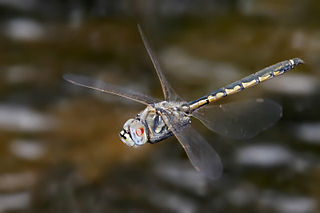
Insects are the only group of invertebrates that have evolved wings and flight. Insects first flew in the Carboniferous, some 300 to 350 million years ago, making them the first animals to evolve flight. Wings may have evolved from appendages on the sides of existing limbs, which already had nerves, joints, and muscles used for other purposes. These may initially have been used for sailing on water, or to slow the rate of descent when gliding.

Robert C. Michelson is an American engineer and academic widely known for inventing the entomopter, a biologically inspired flapping-winged aerial robot, and for having established the International Aerial Robotics Competition. He has received degrees in electrical engineering from the Virginia Polytechnic Institute and the Georgia Institute of Technology. Michelson's professional career began at the U.S. Naval Research Laboratory where he worked on radar-based ocean surveillance systems. He later became a member of the research faculty at the Georgia Institute of Technology. At the Georgia Tech Research Institute (GTRI) he was involved in full-time research, directing over 30 major research programs.

An Entomopter is an aircraft that flies using the wing-flapping aerodynamics of an insect. The word is derived from entomo + pteron. Entomopters are type of ornithopter, which is the broader term for any device intended to fly by flapping wings.

Spacecraft electric propulsion is a type of spacecraft propulsion technique that uses electrostatic or electromagnetic fields to accelerate mass to high speed and thus generate thrust to modify the velocity of a spacecraft in orbit. The propulsion system is controlled by power electronics.

Around 350 BCE, Aristotle and other philosophers of the time attempted to explain the aerodynamics of avian flight. Even after the discovery of the ancestral bird Archaeopteryx which lived over 150 million years ago, debates still persist regarding the evolution of flight. There are three leading hypotheses pertaining to avian flight: Pouncing Proavis model, Cursorial model, and Arboreal model.
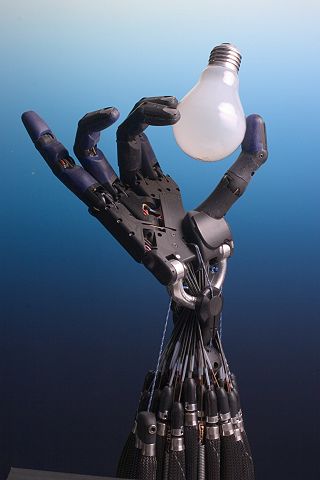
Robotics is the interdisciplinary study and practice of the design, construction, operation, and use of robots.

Nuclear power in space is the use of nuclear power in outer space, typically either small fission systems or radioactive decay for electricity or heat. Another use is for scientific observation, as in a Mössbauer spectrometer. The most common type is a radioisotope thermoelectric generator, which has been used on many space probes and on crewed lunar missions. Small fission reactors for Earth observation satellites, such as the TOPAZ nuclear reactor, have also been flown. A radioisotope heater unit is powered by radioactive decay and can keep components from becoming too cold to function, potentially over a span of decades.
A wearable generator is an article of clothing that contains some form of electrical generation system built in. The concept encompasses a variety of generation systems intended to supply small amounts of power to keep portable electronics in a good state of charge through natural motions of the body.
References
- ↑ http://angel-strike.com/entomopter/RCM-Generations.jpg [ bare URL image file ]
- 1 2 Michelson, R.C., Novel Approaches to Miniature Flight Platforms, Proceedings of the Institute of Mechanical Engineers, Vol. 218 Part G: Journal of Aerospace Engineering, Special Issue Paper 2004, pp. 363–373 https://journals.sagepub.com/doi/10.1243/0954410042794911
- ↑ Colozza, A., Michelson, R.C., et al., Planetary Exploration Using Biomimetics – An Entomopter for Flight on Mars, Phase II Final Report (see chapter on fuels), NASA Institute for Advanced Concepts Project NAS5-98051, October 2002. abstract
- ↑ Michelson, R.C., Naqvi, M.A., Extraterrestrial Flight (Entomopter-based Mars Surveyor), von Karman Institute for Fluid Dynamics RTO/AVT Lecture Series on Low Reynolds Number Aerodynamics on Aircraft Including Applications in Emerging UAV Technology, Brussels Belgium, 24–28 November 2003
- ↑ Michelson, R.C., 'Neurotechnology for Biomimetic Robots, ISBN 0-262-01193-X, The MIT Press, September 2002, pp. 481 – 509, (chapter author)